I’m interested in the way dancers and DJs use the term ‘New Orleans’ when they’re talking about music. Different dancers use the term in different ways. There, are, for example, a number of dancers who’ve moved to New Orleans itself, and use the term ‘New Orleans music’ (or NOLA music or whatever) to refer to all the bands currently playing in that city. The expression is used to refer to a geographic and cultural grouping of bands and musicians. Not all of these are jazz bands. In this post I’m going to try to explore some of the ways ‘New Orleans’ is used in swing dance discourse, and how it carries so many different connotations and functions in so many ways.
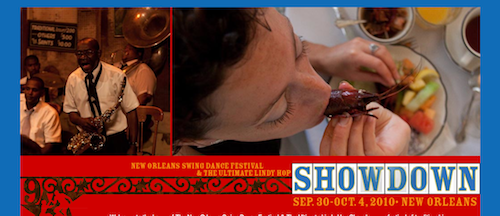
Last year the Ultimate Lindy Hop Showdown, one of the highest profile and most influential events in the lindy community, was held in New Orleans, and it will be again this year. It’s interesting to see how the promotion for Showdown has expanded from an exclusive focus on dancing itself to a broader promotion of New Orleans as a cultural mecca for jazz dancers and musicians. The food and weather and architecture are as important to the event as the social dancing.
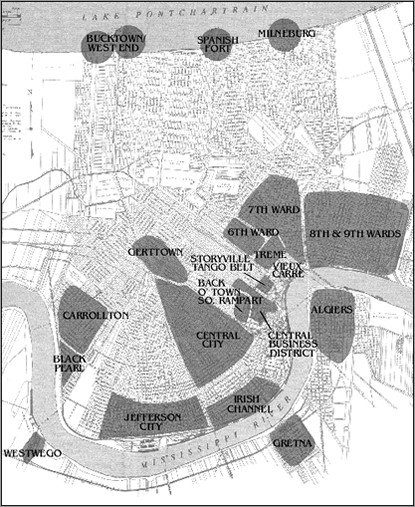
(NOLA map of jazz neighbourhoods from here)
This idea of New Orleans as musically and culturally unique is not new – the HBO series Treme makes that point (rather aggressively) throughout its first season. In this program the music anchors the narrative, both in terms of setting scenes, but also in terms of structuring the lives of some of the main characters who happen to be musicians or music-lovers. Food, however, is just as important, with one main character running a restaurant that later becomes a pivot point for a key plot point, as well as a meeting place for a series of otherwise unrelated characters.
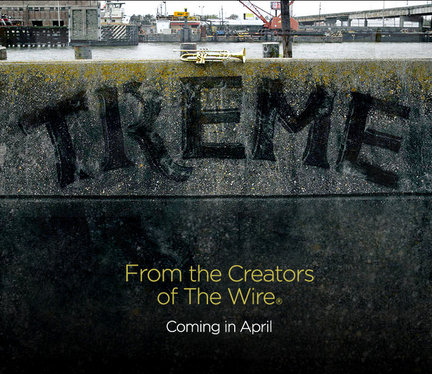
I’m not entirely convinced Treme is the best program out there (though at least this time the characters manage to pass the Bechdel test… just… almost), but it certainly hit the international swing community with a degree of serendipity. Though it isn’t widely watched in Australia (not broadcast here, and really only available through… shall we say, by way of the jolly roger), the music has been trickling down to various DJs and dancers in Australia, coinciding with a growing interest in New Orleans as the home (or at least most recent resting place) of Showdown.
My key source for music from Treme, beyond the program itself, has been the Songs from Treme blog, which I learnt about via twitter and other music and Wire loving friends.
I liked the way the music was largely by independent or by lesser known artists (and so available from my preferred indy sources – CDBaby, emusic and so on), and one of the pleasures of watching the program was identifying artists in the background of scenes. I think, perhaps, that this might be one of the more difficult parts of the program – without these musicians and music to spot, the story line and dialogue are far less complex and interesting than those of the Wire. But then, it’s also interesting to see a program using music in this way.
I think it’s worth pausing to watch the opening credits of Treme (which you can watch on youtube here).
Ken Burns Jazz series spent an inordinate amount of time in New Orleans, and that itself was more than a little problematic. While the city was absolutely central to the development of American jazz, for so many reasons (and we have to mention its role as a sea port and consequent role as a gathering point for musicians of so many international cultures and traditions), it was not and is not the only place in that country (or others) contributing to the development of jazz. I mention this program because it is so iconic, and because it plays such a key role in Australian swing dance culture. It saw the release of a series of very useful CDs, a fascinating book, and of course, a range of DVDs which even mention lindy hop at one point.
But I think John Goodman’s ill-fated character makes the best point of all in Treme when he reminds his Youtube audience that the city is more than the picturesque French quarter and live jazz. It is also political corruption, a disturbing crime problem, grinding poverty and burning racial tensions. Many Australian or international dancers, I think, would be surprised to see not only the devastation still remaining from Katrina, but also the ground-in social difficulties beyond the wrought-iron and narrow streets of the tourist quarter. A jazz fan might argue that it is out of these conditions that jazz was born, but I’m fairly sure a New Orleans local might also like (or even prefer) reliable electricity and political ethics.
This brings me (in a roundabout way) to my original point. The way dancers use ‘New Orleans’ when they’re discussing music for dancing. I’ve heard it used in a number of ways, including contexts where I’ve thought ‘hey, that’s just wrong’. But then, language is flexible and jazz dance reminds us every single day that there’s no right or wrong, just the way that you do it.
When I say ‘New Orleans’ jazz, I’m referring to one (or a number of) these:
Music or musicians currently working in the city itself.
So I might be talking about various parts of the Loose Marbles or other ‘street bands’ working in or hailing from New Orleans. Not all of these are jazz or in the jazz tradition. But the bands dancers in Australia tend to be most interested in are.

One of my favourite songs from the Treme soundtrack is ‘Shallow Water’ by Donald Harrison (which you can listen to here. I love this song for running, and I also love it for the way it ties into the story arc considering the New Orleans indians and Big Chiefs (who fascinate and delight me with their costumes, posing and strutting and cultural appropriation of native American imagery in combination with very African practices and rhythms). But I wouldn’t play this song at a swing dance, even though the complicated rhythms work perfectly with the complicated rhythms we dance and hear in jazz.
So when most dancers talk about the great bands that they saw in New Orleans, or the great CDs they’ve just bought or the songs they’re playing for dancers, most of them aren’t talking about Donald Harrison, they’re talking about the younger street bands, recreationist bands like the New Orleans Jazz Vipers, The Palmetto Bug Stompers, Tuba Skinny, Meschiya Lake and the Little Big Horns or perhaps (at a pinch) not-quite-street-band-people like Kermit Ruffins or the (incomparable) Preservation Hall Jazz band. I often find that a lot of dancers conflate all the recent round of street jazz bands as ‘New Orleans’, even if they’re not from New Orleans. This might include bands like the Cangelosi Cards, Tin Pan or Baby Soda.
Music or musicians of the ‘jazz’ era who hailed from New Orleans.
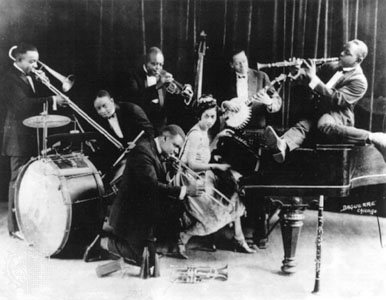
(pic of the King Oliver Jazz Band stoled from here)
This includes people like Louis Armstrong, Lil Hardin, Jelly Roll Morton and so on. While their earlier stuff is definitely ‘New Orleans’, and artists like Armstrong made great mileage from New Orleans revival type music in the 40s and 50s, these guys didn’t stand still, musically speaking. Armstrong (who is the most obvious, but certainly not the only example) developed from his work as a musician in King Oliver’s band to doing hardcore big band swing, and then ballads, torch songs and a whole range of other things. So simply identifying a musician as ‘New Orleans’ might give you an idea of their history or their influences, but really isn’t enough to describe their entire career or every song they played.
Music of the ‘New Orleans’ style.
Now this is where I’ve seen the greatest range of opinions. I heard a dancer the other night describe a song by Artie Shaw that I was playing as ‘New Orleans’. This surprised me as Shaw was white, born in New York, grew up in Connecticut and isn’t known as a New Orleans style musician at all. I think, in that case, the dancer meant that this song wasn’t groove, or was earlier, or classic jazz.
I could imagine a difference of opinion about whether a musician was ‘New Orleans’ or ‘Chicago’, particularly as many jazz musicians left New Orleans for Chicago in the 20s, and you can hear the music shifting as it moved between cities. But even then, there’s quite clear distinctions…
What I think a lot of dancers mean, when they say a song is ‘New Orleans’ is that it has a sort of raucous collective instrumentation (as opposed to the tightly arranged big bands of the 30s and later), where musicians improvise within the structure of an arrangement. Most of these band have about eight or fewer musicians, as this sort of musicality is difficult to hold together with bigger bands. I seem to remember Gunther Schuller talking about this, but I’d have to look it up, and the book’s downstairs.
This type of band really tended to dominate the 20s, but was later ‘revived’ in the 30s and 40s by the ‘moldy figs’ and others who held that swing was modern and not really ‘true’ jazz at all – a highly contentious argument that particularly shat the bebop jazz musicians.
Instrumentation tended to include a tuba player (to replace the bass player), a drummer who played a sparser, pared back kit (or who was even replaced by a washboard player or other type of rhythm instrumentalist – playing a suitcase or other simple rhythm instrument), some brass (trumpet or cornet, a trombonist…) and perhaps a pianist, if a piano was to be had. There were often lyrics, provided either by a guest vocalist, by one of the band, or by the band ensemble.
Blues-structured songs would often dominate the repertoire of these bands, but not necessarily so. Singers were not amplified, and it’s not surprising that shouters are associated with these bands, even though they might not necessarily have begun with these bands at all. The singing style of musicians like Meschiya Lake certainly encourage this association.
Timing-wise, the rhythm was often 2/4, or felt like 1-2, 1-2, 1-2 rather than 1-2-3-4 of later swing (and of course there’s the Basie quote: “I can’t dig that two-beat jive the New Orleans cats play; cause my boys and I got to have four heavy beats to a bar and no cheating”). This is a tricky thing to talk about, and I don’t really have the language for it. It’s not right to say that all New Orleans jazz (then or now) was 2/4 or even that it all had that uppy-downy feeling rather than the flatter, 4/4 time swing does. But if I hear a song with that sort of instrumentation, in 2/4 time or with that really uppy-downy rhythm that makes me want to do 20s charleston rather than low, flat out lindy hop, I tend to think ‘New Orleans’, even though it’s not strictly accurate.
I use ‘New Orleans’ in my music collection to identify a particular type of music or sound. I distinguish between 20s society jazz, 20s big band jazz, 20s hot big bands and New Orleans jazz. If it gets the New Orleans tag from me, it’s hot (as opposed to sweet), it’s a smaller band, it has that collective improvisation (which often sounds like a bunch of pots being thrown around) and it doesn’t have a shuffle rhythm in the drum section. But I wouldn’t use this definition to discuss or describe the music to another person in conversation. I feel a bit strange writing it here.
But I also want to note one other type of music which falls under the New Orleans umbrella, but which I don’t think is quite the same:
New Orleans revival.
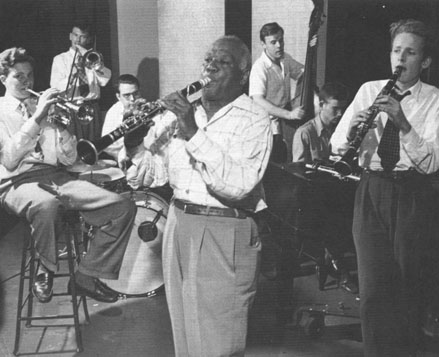
(Sidney Bechet with Bob Wilbur, as stoled from Riverwalk Jazz)
There was, literally, something of a New Orleans revival in the 30s and 40s. I’ve read a bit about it, but from what I can gather from some really unreliable sources (and I just don’t know if it’s a true story or not), this revival was prompted by white music fans, including those writing jazz magazines (I’d have to check the titles I’m afraid, but I have made a list of my posts approaching this topic here), and eventually running jazz festivals. These guys felt that the ‘modern’ jazz of the day (swing and later bebop) wasn’t ‘real’ jazz, and so they sought out surviving musicians (like Bunk Johnson) and got them to record.
Other musicians rerecorded or revisited their stuff from the 20s as well, so you get people like Sidney Bechet recording New Orleans standards in the 40s and 50s. They’re great songs, it’s great stuff. But it often has some different stuff going on in the rhythm section (the drums is where I hear it most – a shuffle rhythm rather than cooking pots clashing and bashing or steady thump). It also often feels as though the uppy downy beat is smoothed out a bit, swung a bit. For me, this often leaves me thinking ‘should I charleston or lindy hop to this?’
Interestingly, I’ve noticed that a lot of Australian jazz clubs (in both Sydney and Melbourne anyway) favour this sound. I think this is because the New Orleans revival sound was very popular in Australia in the 40s and 50s. Which is interesting as well because black American musicians were not allowed into Australia from about 1928 until the mid 1950s (I track my (limited) research into this topic in this post, which includes a pic of the American band that prompted the ban). The ban was initiated for a number of (racist) reasons, but also because of pressure from the Australian musicians union. So the Australian jazz musicians and scene gained their influence not from seeing and jamming with African American musicians, but from records, visiting white musicians, magazines from the United States and their occasional trips overseas. Needless to say, most Australian jazz musicians were (and are) white. So the sound that dominates much of Australian jazz is what I’d think of as ‘New Orleans revival’. Even though it’s probably not really accurate.
…concluding….
Ok, so this post is really just an overview of some of the things I’ve noticed about the way people use the term ‘New Orleans’ in discussions about music for dancing. It’s probably very inaccurate, and I’ll probably disagree with it myself in a little while. But I wanted to write this because the street bands of New Orleans are very popular at the moment with more experienced Australian dancers. The 20s sound generally is very popular, in part because it’s chic with America’s experienced dancers (who teach here in Australia) and at the highest profile American events (which we experience via Youtube, Facebook and stories from returning travellers).
I also want to state that though I’m very fond of these bands, and some are extraordinarily good, I do have reservations about their dominance. I’ve started pushing for solid, big band swing in my sets, and I’ve really started missing this stuff in other DJs’ sets. In Sydney we hear all sorts of music, so I’m ok here. But I do hear a lot of that other stuff in other cities. While I do love the smaller bands, there’s nothing quite like a big band in full flight. And I do miss the flattened out feeling of a really good, swinging rhythm. I do have some concerns about what I see in some dancers dancing – lots of flattened feet, a flatter, unbouncy lindy hop and a general economy of movement which suits the scorching tempos and unpredictable nature of the collective improvisation of this stuff. While there’s amazing stuff going on, sometimes I worry that the more interesting stuff – the greater range of arm movements, feet way off the ground, the triple steps and so on – are neglected.
But then, really, who the fuck am I to pass judgement on this stuff? It’s all dancing, and dancing is a Good Thing. And, to be honest, I really like to see dancers experimenting with form and style and musicality. And it’s a very wonderful thing to see young musicians working with this music and dancers supporting new bands by buying their CDs and booking them for gigs.

Having just been to New Orleans I felt I had to add something here. Post-Katrina there definitely seems to be something of a resurgence of interest in New Orleans jazz (whatever the hell that actually means). Firstly: A lot of dancers have been moving to New Orleans and there does seem to be some friction between this new group and the ‘local’ dancers – although everyone seems friendly enough to visitors.
Secondly: New Orleans doesn’t have a monopoly on corruption or crime or entrenched social and racial disadvantage as far as north american cities go. What it does have though is the aftermath of Katrina. Although the city’s population seems to have largely recovered this is due to an influx of new residents – many who lived there before the storm haven’t returned. And although you have to know what you’re looking for to see the Hurricane’s effects in the more touristed parts ot the city large parts of East New Orleans are still virtually uninhabited.
Musically I think that Seattle has something to do with the current interest in New Orleans music, due to the size and mobility of that scene and it’s relationship with New Orleans.
More generally I think that the current interest has something largely to do with dancers preferring ‘hotness’ in music. There are few big bands around at the moment producing what I would characterise as hot music – and although there are plenty of small groups playing sweet music there are more current small bands producing hot music (generally with a strong New Orleans or Trad influence) than big bands producing hot music.
I guess one other interesting point that you touched on was that whilst (and it’s debateable) New Orleans was the birthplace of jazz – it hasn’t always been it’s home. It has waxed and waned there over the 20th century with resurgences in the 40’s and 50’s with dixieland, and again in the 60’s with the foundation of Pres. Hall. I think we’re currently witnessing another resurgence in interest in music heavily influenced by jazz roots and the focal point does seem to be New Orleans. I think that this is due to a number of factors and that the recovery from the Storm is one of them. The city and a number of philanthropic groups have taken a key interest in supporting musicians and although there’s much more to New Orleans than just trad jazz(from the brass funk styles of the Rebirth Brass Band and Trombone Shorty, to rock and rockabilly, to sweet swing to brass bands like the Treme Brass Band and more) there seems to be an emphasis on what the bands themselves call (mind-you to tourists) “Traditional New Orleans Jazz” .
I too would like to hear more hot, hard swingin big band music. Perhaps we should play a lot of it on Friday at Church Pit(though I do have a lot of new seriously good small group stuff, both New Orleans and otherwise that I’m wanting to bust out). :)